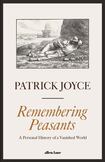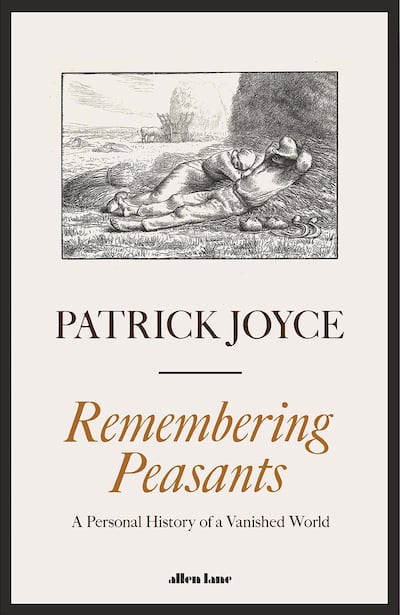
What is a peasant? A campesino? A labourer of the land? We all think we know what that term means, but has it been fully explored? Has it been delved into? To speak of the peasant is to speak of the terra sanctus and the terra firma and, in no small way, to speak of our earth-clodden forebears.
Patrick Joyce, emeritus professor of history at Manchester University and a leading social historian, is part of that great class. The son of Irish immigrants to the UK who had come from small farms in rural Ireland. Joyce is both an insider and an outsider in his profound book Remembering Peasants: A Personal History of a Vanished World. Joyce is, and I will be honest here, my new hero.
At the start of this fascinating study, Joyce invokes that great documenter of peasant life, John Berger, the British Booker Prize winner who moved to France and documented peasant life there in his trilogy Into Their Labours. Joyce is right to do so, for both he and Berger have and do provide insight and a lived experience of that class that has lived next to capitalism for centuries.
Capitalism and peasants don’t always seem to mix. And yet, as Joyce explains, the peasant has been one of the few who did not conform to live within it and in ways against it. The peasants sought only to survive and so, as Joyce relates, never exposed themselves too much to the ravages of the “unlimited increase” of that system.
Joyce, as the book unfolds, explores his own family history from Mayo to industrial Britain. His familial story is not a radically new one in a society that has been forged in the shadow of migration and emigration for centuries, but in his hands we see the story of not just Ireland, but that of the peasant class throughout the world.
[ JF Murray: BookToker and author on needing ‘that fun dopamine hit on every page’Opens in new window ]
The Irish language, he rightly says, does not have a word for peasant; or, rather, there is no word beyond country person or tuathánach, which is neutral. Yet despite lacking the term used by the French and British, ours was a society formed of farming stock.
I am reminded of John McGahern’s statement that Ireland, until the 1970s, was living in a 19th-century world. What McGahern meant was that it was an agrarian world. Joyce has delved deep into that world to uncover its origin, its decline and its current situation.
The peasant has always been part of the social system and always at the bottom of it, cannon fodder for a war, bearing the brunt of taxation, etc, even as it provided the food and labour to drive everything else
Joyce begins telling us of the vanishing of peasants by talking of his cousin, a bachelor farmer in the west of Ireland. Seán was part of what we in the midlands call the bachelor class, the small farmer or, as Joyce puts it, farmer-cum-peasant, who occupied a world well into the 1990s that was part of the peasant society across the world. But the bachelor farmers are nearly all gone. Seán serves as an emblem of the other peasants across Europe (and, indeed, the world) who are dying out or dead already.
The vanishing, as the author puts it, is a global event. As a species, we are now an urban one. In the 1950s, some 20 per cent of humanity lived in urban centres. Now it is approaching 60 per cent. Many of those who moved to cities were in the global south. Those involved in agriculture fell from 44 per cent in 1991 to 27 per cent in 2019.
But not all peasants are made equal. Joyce here does an excellent job of bringing us around Europe to different peasant societies
In our own island, as the author says, in the 1950s as much as a fifth of our population left for British cities. The falling silent of the countryside is, he explains, a global pattern. Across Europe, those involved in agriculture make up less and less of our societies. In Germany, by way of example, it is 1 per cent.
In ways, the third agricultural revolution, which brought new methods of farming and the anthropogenic age we now live in with all its climate problems, helped to further hasten the demise of the peasant. By 2021, agriculture accounted for a little over 1 per cent of GDP in the EU.
But not all peasants are made equal. Joyce here does an excellent job of bringing us around Europe to different peasant societies. In the south of Italy, the Latifundia system, formed by vast absentee-owned estates “geared to national and international capitalist markets” had been in existence as far back as the Roman times and was abolished in 1950.
We then look at eastern Europe and Russia, where serfdom was the norm and remained so long after it had ended in the West. Joyce explains that serfdom was essentially “a system of indentured servitude and debt bondage”. The problems facing such people, however, did not stop after serfdom ended.
We know something in this land of the history of small plots of land being worked by large families, a system that failed when the Great Famine of the 1840s struck. But Ireland was not alone in small plots of land being cultivated. In Poland in 1899, 80 per cent of peasant plots were less than 5 acres in size. This problem worsened in the second half of the 19th century despite a marginal increase of arable land available. The peasant population almost doubled and many were heavily in debt or had lost land to moneylenders.
Harking back to Ireland and our nearest neighbours, we learn that in 1861, 710 individuals owned a quarter of England and Wales, and almost three-quarters of Britain and Ireland were in the hands of fewer than 5,000 people. These are shocking numbers.
The level of craftsmanship in the book is evident, but so too is its heart and soul. Reading it, I was changed and charged
The vast sweep of the book serves to remind us of the sheer importance of land to the peasants. It is, as Joyce says, “a means of survival”. The peasant does not see the land as we do, he explains. Nature or wilderness are not things the peasant has time or a liking for. Indeed, this is made most interesting in his story of a Polish peasant view of the United States, where a mountain, a thing we would look at for its sheer beauty, was seen as an “awful view”. The flat plain, where a farm might be established, was by contrast beautiful. The domestication of land was a world that became familiar.
Joyce brings this idea further when he harks back to the townlands of Ireland, and one is reminded here of the highly localised world the peasant or small farmers lived in, not just in Ireland, but across Europe. The localisation led to naming things, not least fields. This tradition still follows in today’s Ireland, where land is known and named. The names of fields take on special meaning to farmers because many are handed down to the modern era even in a more urban country like ours. Things we thought of as Irish are also part of the pan-European peasant culture. We might have been at the edge of Europe, but we shared things with other agrarian societies.

The author has built up through his stories, facts and insights from Italy to Poland to Ireland a mental map of a world and how it has been shaped. But perhaps most striking of all is when Joyce details his own family.
The home place, a central idea in rural Ireland to this day, is seen with his expert eye as the hearth at the centre, a place not just where the fire kept things and people warm, but the centre of a universe. Joyce’s home houses were Wexford and Mayo, but also working-class London. Ireland and England are the places that formed the author. This is the source of the memory palace.
Books such as Remembering Peasants are landmarks and waymarkers. They tell us of a hidden world, a vanishing world or indeed a vanished world. This is important, vital writing and study. The level of craftsmanship in the book is evident, but so too is its heart and soul. Reading it, I was changed and charged.
As a descendant of peasants, as perhaps a member of the last generation to remember parts of this world, I was reminded so much of a different Ireland. An Ireland that is now more or less gone. Joyce is essential reading for anyone who cares about our shared past.
Further reading
- John Berger’s Into Their Labours trilogy (1991, Granta) – Pig Earth (1979), Once in Europa (1987), Lilac and Flag (1990) – is a masterful body of work detailing the peasant people the Englishman had come to live among in the latter part of his life. Pig Earth stands out as a brilliant book within this trilogy and one to be savoured.
- For those interested in agrarian literature, the writings of Wendell Berry, a Kentucky-based writer and farmer, inform one of the great struggles of the American farming class and just how much they have gone through. It All Turns on Affection: The Jefferson Lecture and Other Essays (Counterpoint, 2012) is a great and easy way into this farmer’s writing.
- A last book readers might enjoy is a modern telling of rural life in the form of The Shepherd’s Life (Allen Lane, 2015) by farmer and writer James Rebanks. In it, he details his life and work in England’s Lake District. It is a fantastic book that wowed critics on both sides of the Atlantic, and rightly so.













